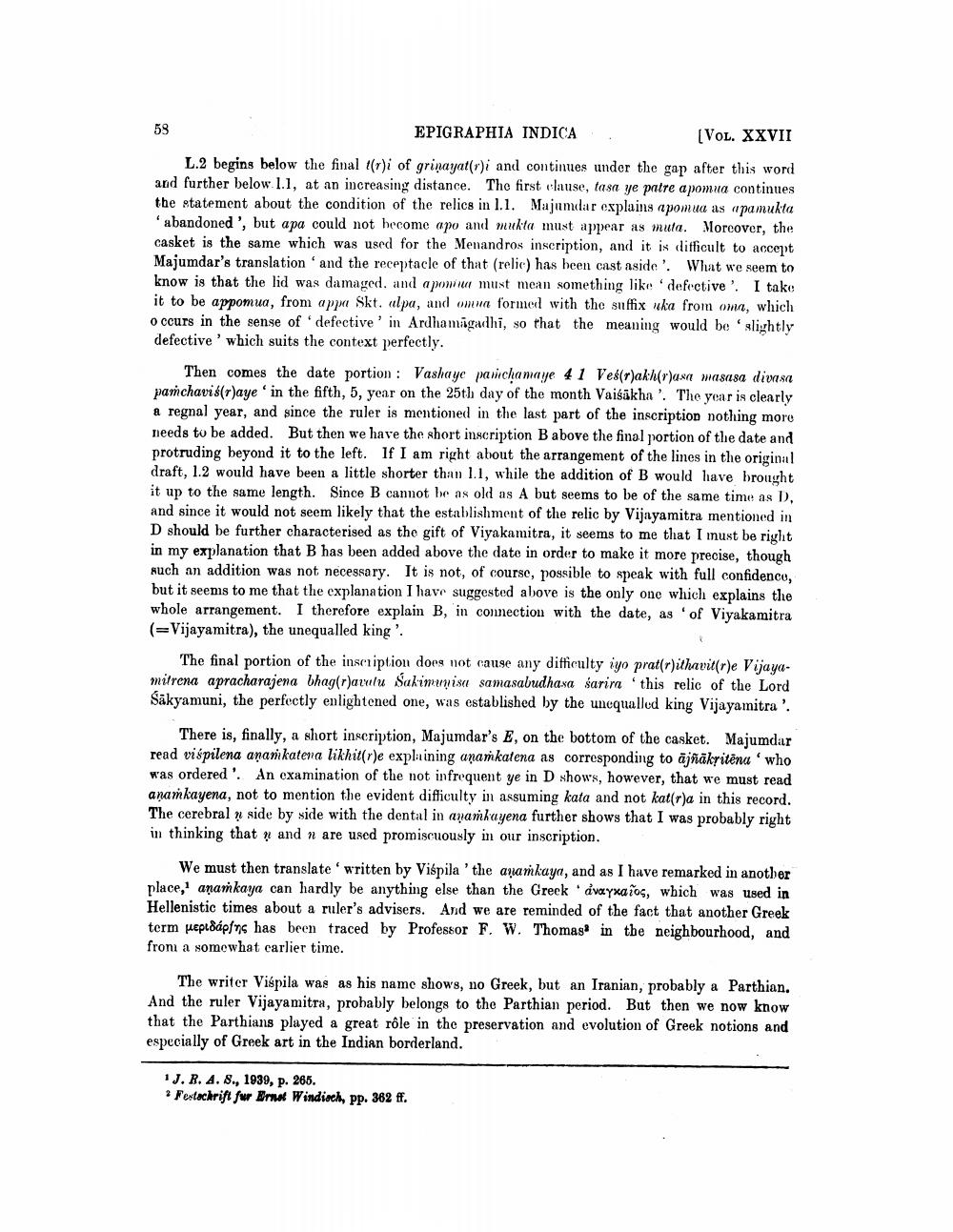________________
EPIGRAPHIA INDICA
(VOL. XXVII
L.2 begins below the final t(r)i of grinayat(r)i and continues under the gap after this word and further below. 1.1, at an increasing distance. The first clause, tasa ye patre apomua continues the statement about the condition of the relics in l.1. Majumdar explains apomua as a pamukta
abandoned', but apa could not become apo and mukta must appear as muta. Moreover, the casket is the same which was used for the Menandros inscription, and it is difficult to accept Majumdar's translation and the receptacle of that (relic) has been cast aside'. What we seem to know is that the lid was damaged, and a pominu must mean something like defective! I take it to be appomua, from appa Skt. alpa, and omna formed with the suffix wka from oma, which occurs in the sense of defective' in Ardhamagadhi, so that the meaning would be slightly defective' which suits the context perfectly.
Then comes the date portion : Vashaye pani chamaye 41 Ves(r)akh(r)asa masasa divnsa pamchavis(r)aye in the fifth, 5, year on the 25th day of the month Vaisakhn'. The year is clearly a regnal year, and since the ruler is mentioned in the last part of the inscription nothing more needs to be added. But then we have the short inscription B above the final portion of the date and protruding beyond it to the left. If I am right about the arrangement of the lines in the original draft, 1.2 would have been a little shorter than 1.1, while the addition of B would have brought it up to the same length. Since B cannot be as old as A but seems to be of the same time as D. and since it would not seem likely that the establishment of the relic by Vijayamitra mentioned in D should be further characterised as the gift of Viyakamitra, it seems to me that I must be right in my explanation that B has been added above the date in order to make it more precise, though such an addition was not necessary. It is not, of course, possible to speak with full confidence, but it seems to me that the explanation I have suggested above is the only one which explains the whole arrangement. I therefore explain B, in connection with the date, as of Viyakamitra (=Vijayamitra), the unequalled king'.
The final portion of the inscription does not cause any difficulty iyo prat(r)ithavit(r)e Vijayamitrena apracharajena bhag(r)azulu Salimenisa samasabudhasa sarira 'this relic of the Lord Säkyamuni, the perfectly enlightened one, was established by the unequalled king Vijayamitra'.
There is, finally, a short inscription, Majumdar's E, on the bottom of the casket. Majumdar read višpilena anamkatena likhit(r)e explaining anamkatena as corresponding to ajñākritēna who was ordered'. An examination of the not infrequent ye in D shows, however, that we must read anamkayena, not to mention the evident difficulty in assuming kata and not kat(r)a in this record. The cerebral » side by side with the dental in anamkayena further shows that I was probably right in thinking that and n are used promiscuously in our inscription.
We must then translate written by Vispila 'the anamkaya, and as I have remarked in another place, anaṁkaya can hardly be anything else than the Greek évayxaios, which was used in Hellenistic times about a ruler's advisers. And we are reminded of the fact that another Greek term wept8áplnis has been traced by Professor F. W. Thomas in the neighbourhood, and from a somewhat carlier time.
The writer Vispila was as his name shows, no Greek, but an Iranian, probably a Parthian. And the ruler Vijayamitra, probably belongs to the Parthian period. But then we now know that the Parthians played a great rôle in the preservation and evolution of Greek notions and especially of Greek art in the Indian borderland.
1J.R. A. 8., 1939, p. 265.
Pestackrift fur Ernst Windisch, pp. 362 ff.




